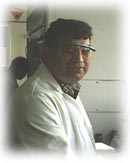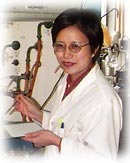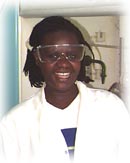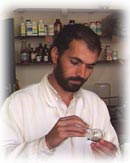


|
|||
 |
| ||
Research Groups | |||
Research InterestsThe Read group is concerned with the synthesis of natural products and other molecules of biological interest. Current targets include halogenated lactones from marine sources, lignans, indoles, bisisoquinolines, and muscarinic antagonists. We are also interested in stereochemical issues, especially as they pertain to selectivity, and the modern field of parallel and combinatorial approaches to chemical synthesis. The following topics give an indication of our activities. 1. Probing the structure-activity properties of biological signalling molecules(with Dr Naresh Kumar, Anthony Manny (below, left) and William Lao (below, right)) Fimbrolide lactones and N-acyl homoserine lactones participate in a very subtle signalling exchange that controls settlement and growth of bacterial films. We are engaged in the synthesis of analogues of both signalling types and aspects of large-scale synthesis. The research is carried out in close collaboration with scientists in the Schools of Biological Science and Microbiology and Immunology.
A.J. Manny, S.Kjelleberg, N. Kumar, R. deNys, R.W. Read, P. Steinberg, Tetrahedron, 1997, 53, 15813-15826 2. Ketone-enolate Michael reactions(with Hafeez Shahid) 
The Michael reaction is a powerful means of constructing carbon-carbon bonds. We are examining a less well studied version of the reaction in which ketone enolates are added to unsaturated esters (scheme below). This process is being exploited as one of two key steps in a total, stereocontrolled synthesis of spirodienone natural products, including the eupodienone lignans. Progress has also been made in the other key step, that of nitroalkene cycloaddition.
3. New muscarinic receptor ligands(with Xue-Qin Shi) 
We have recently reported the synthesis of a small family of dibenzodiazepinyl amides and are currently engaged in the synthesis of another class of compounds as potential muscarinic receptor ligands. The M2 muscarinic receptor subtype appears to be closely linked to the onset of dementia and in this project we are investigating ligands that can be used as diagnostic agents for the detailed study of these diseases through collaboration with a group at Royal Prince Alfred Hospital. M. Kassiou, X. Shi, R.W. Read, Bioorg. Med. Chem. Lett., 1997, 7, 799. 4. A combinatorial approach to indole synthesis(with Teresa Oduor) 
Indoles are widespread in nature and are present as structural elements in a vast number of bioactive substances. This group has developed a solution phase synthesis of ring-fused indoles through cyclisation of benzalhydantoin derivatives (scheme below). The approach has been extended to the use of piperazinedione derivatives and a detailed comparison of these parallel processes and subsequent reactions, using combinatorial methods is underway. D.StC. Black, M. Kassiou, T. Oduor, R.W. Read, RACI, 16th National Organic Division Conference, Leura, 12-17 July 1998 5. Novel bisisoquinoline ligands(with Zaher Judeh) 
We have discovered that bisisoquinolines can provide an extremely wide variety of interesting ligand types through simple manipulation of substituents. The compounds are robust but can undergo interesting conformational changes that make them attractive as components of supramolecular devices. New synthetic analogues and applications are being investigated. 6. New fluorous reagents(with Zhang Chutian) There is considerable advantage in performing chemistry in highly fluorinated solvents, however, there are few reagents available at present that are soluble in these solvents and can be used for this purpose. We have established a collaboration with Prof D.P. Curran, a leader in this field at the University of Pittsburgh, and are separately examining the chemistry of a series of highly fluorinated diol reagents that might be used in acetalation chemistry.
|